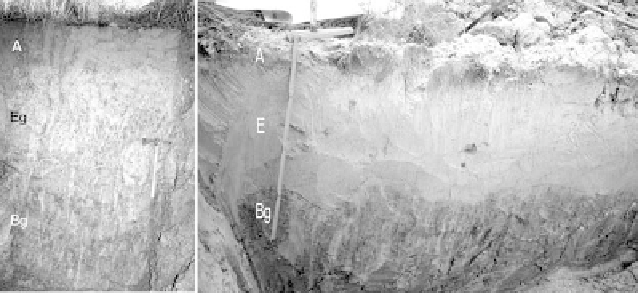Geoscience Reference
In-Depth Information
Fig. 8.9
Left: Albeluvisol on variegated clays of le Bourbonnais (Diou quarry, confl uence
of the Loire and Allier rivers, France). Light-grey loamy sand A horizon, mostly bleached Eg
(g = redoxic features) and rust-coloured Bg with white degradation tongues. Ferruginous
concretions (black spots) are clearly visible in E and B.
Photo
: author. Right: Planosol from
Guyane. The E/B boundary is clear. The E horizon is totally deferrifi ed.
Photo
: J.C. Favrot.
8.3
TYPOLOGY AND CLASSIFICATION
The
argic
(WRB) and
argillic
(Soil Taxonomy) horizons correspond
to the same concept of a horizon enriched in clay, at least partially
through illuviation. The definition of the argic horizon states: '
The
textural differentiation may be caused by an illuvial accumulation of clay, by
predominant pedogenetic formation of clay in the subsoil or destruction of clay
in the surface horizon
…'.
Their features are precisely defined in the corresponding systems,
which should be referred to. Essentially the following are considered:
Argic and argillic horizons
position in the profile,
thickness (minimum required) and also the enrichment in clay
compared to the average particle-size distribution of the materi-
als present,
mineralogical composition: a higher cation exchange capacity
distinguishes the argic horizon from the
ferralic
horizon,
colour and internal structure (clay films more or less
obligatory),
COLE (Chap. 6, § 6.3); actually, absence of signs of illuviation
is tolerated in certain soils in which they can be destroyed by
swelling and shrinking,

